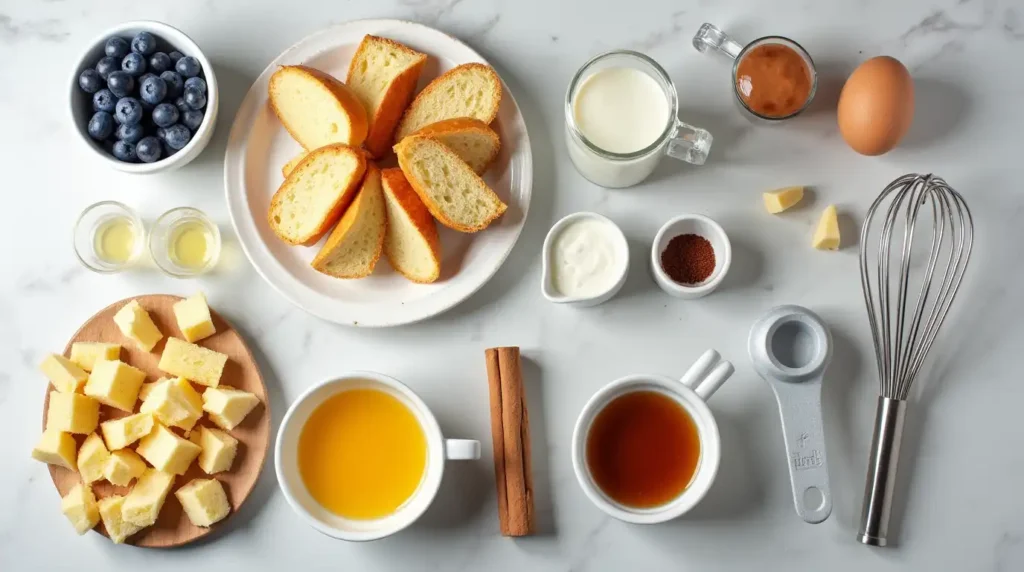Table of Contents
Blueberry French Toast Casserole is the ideal solution when you want a dish that’s comforting, indulgent, and simple to prepare. This make-ahead breakfast casserole combines the richness of traditional French toast with the fruity brightness of fresh blueberries, all baked into one irresistible dish. Whether you’re feeding a crowd or just treating yourself to a weekend breakfast upgrade, this recipe delivers.
What makes this dish a standout isn’t just its flavor—it’s also its versatility. You can prep it the night before, let it soak, and just pop it in the oven in the morning. That makes it perfect for holidays, brunch gatherings, or even lazy Sundays. It’s also one of those easy brunch dishes that doesn’t sacrifice flavor or presentation. For those looking to explore overnight casseroles, Serious Eats explains why custard-based recipes benefit from extended soaking.
If you’re curious about why French toast bakes have become such a hit, it might be the rise in popularity of sweet breakfast casseroles that feel indulgent but are easy to customize. For instance, The Kitchn offers a deep dive into bread pudding-like breakfast recipes that can be tailored to seasonal ingredients like blueberries.

What Is Blueberry French Toast Casserole?
This baked French toast dish is a hybrid of classic French toast and bread pudding. You start with cubes of sturdy bread, toss in a generous helping of blueberries, and cover it all with a rich egg custard. After soaking, the mixture bakes into a creamy, slightly crispy-on-top casserole that’s ideal for breakfast or brunch.
Unlike stovetop French toast, this dish is hands-off once it’s in the oven. Plus, the blueberries soften and burst during baking, adding natural sweetness and color.
Why You’ll Love This Recipe
- It’s a true make-ahead brunch recipe.
- Uses simple ingredients most people already have at home.
- Great for feeding a crowd—8 to 10 servings in one pan.
- Leftovers store and reheat beautifully.
Ingredients Breakdown
Bread
Choosing the right bread is key to the perfect texture.
- Brioche – Buttery, soft, and rich.
- Challah – Slightly sweet, eggy bread that soaks up custard well.
- French bread or sourdough – Adds chewiness and structure.
Stale or day-old bread is best to absorb the custard without turning soggy.

Blueberries
- Fresh blueberries are ideal for their bright flavor and texture.
- Frozen blueberries can be used too, but don’t thaw them first to prevent color bleeding.
Custard Base
The custard brings everything together. You’ll need:
- Eggs (usually 6–8)
- Whole milk and heavy cream for richness
- Sugar (white or brown)
- Vanilla extract
- Optional: lemon zest or almond extract for a flavor twist
Optional Add-ins
- Cubed cream cheese for a cheesecake-style texture
- Streusel topping made with flour, butter, and sugar
- Chopped pecans or walnuts for crunch
Step-by-Step Preparation Guide
1. Prep the Pan
- Grease a 9×13-inch baking dish with butter or non-stick spray.
2. Assemble the Layers
- Spread half of the bread cubes in the dish.
- Sprinkle half of the blueberries and optional cream cheese over the bread.
- Repeat with the remaining bread and blueberries.
3. Mix the Custard
- In a large bowl, whisk together the eggs, milk, cream, sugar, and flavorings.
- Pour the mixture evenly over the bread layers.
4. Let It Soak
- Cover and refrigerate for at least 4 hours or preferably overnight.
- This step helps the custard fully absorb into the bread.
5. Bake
- Remove from the fridge 30 minutes before baking.
- Preheat the oven to 350°F (175°C).
- Bake uncovered for 45–55 minutes until golden brown and set in the middle.
6. Serve
- Let it rest for 10 minutes before slicing.
- Serve with maple syrup, powdered sugar, or fresh fruit.

Variations and Customizations
Fruit Variations
- Raspberries or strawberries for a red berry twist
- Peaches for a summery stone fruit option
- Mixed berries for variety
Flavor Enhancements
- Add cinnamon, nutmeg, or pumpkin spice
- Citrus zest adds brightness
- Almond extract for a hint of nuttiness
Dietary Swaps
- Almond, oat, or coconut milk for a dairy-free version
- Gluten-free bread for those with intolerances
- Skip the cream cheese or use dairy-free alternatives
Toppings
- Brown sugar-cinnamon streusel
- Crushed nuts
- Drizzle of lemon glaze or fruit syrup
Expert Tips for Success
- Dry out your bread beforehand by leaving it out overnight or toasting it.
- Gently press the bread into the custard to ensure even absorption.
- Don’t overbake—the center should be set but still moist.
- If using frozen blueberries, toss them with a bit of flour before layering to prevent sinking.
Serving Suggestions
- Pair with crispy bacon or sausage for a savory balance.
- Serve with freshly brewed coffee or herbal tea.
- Make it the star of a holiday brunch spread alongside mimosas and fruit salad.
Storage and Reheating Instructions
Storage
- Store leftovers covered in the fridge for up to 4 days.
- Freeze in individual portions for up to 2 months. Use airtight containers or wrap in foil and place in freezer bags.
Reheating
- Oven: Cover with foil and bake at 325°F until warm (about 20 minutes).
- Microwave: Heat individual portions in 30-second intervals.
Frequently Asked Questions (FAQs)
What is the most common mistake when making French toast?
Using bread that’s too fresh or soft is the most common mistake. It doesn’t absorb the custard well and becomes mushy. Day-old or lightly toasted bread is ideal for the best texture.
Why is my French toast casserole soggy?
Sogginess usually happens when the bread is too fresh, too much custard is used, or the casserole isn’t baked long enough. Use sturdy, stale bread and bake until the center is fully set.
What bread is best for French toast casserole?
The best options are brioche, challah, sourdough, or French bread. These absorb the custard well without falling apart, giving you a rich, balanced texture.
What is the trick to not soggy French toast?
Use stale or toasted bread, don’t oversoak it, and bake until the center is just set. Letting it rest after baking helps it firm up and prevents excess moisture.
Why is French toast unhealthy?
French toast can be high in sugar, fat, and calories due to ingredients like white bread, cream, butter, and syrup. You can lighten it up by using whole-grain bread, less sugar, and healthy toppings.
Is milk or heavy cream better for French toast?
Heavy cream gives a richer texture, while milk is lighter. A mix of both offers a balance of flavor and consistency in the custard.
Do you have to let French toast casserole sit overnight?
It’s not required, but letting it sit overnight allows the custard to fully absorb into the bread, improving texture and flavor. A minimum of one hour is recommended if you’re short on time.
How many eggs per French toast?
For individual slices, use about 1 egg for every 2 slices. In a casserole, 6 to 8 eggs usually work well for a 9×13-inch dish, depending on how rich you want it.
Can you use croissants for French toast?
Yes, croissants work beautifully. They’re buttery and absorb custard well, resulting in a tender, decadent texture.
What is the secret to the best French toast?
Start with quality bread, make a well-balanced custard with milk or cream, let the bread soak properly, and cook or bake at the right temperature to achieve a golden exterior with a soft center.
Why add milk to eggs for French toast?
Milk helps transform eggs into a custard, giving French toast its creamy interior instead of a scrambled texture. It ensures even coating and better flavor.
How long to soak French toast?
Slices need about 10 to 20 seconds per side if the bread is stale. For casseroles, at least 1 hour is recommended, though overnight soaking produces the best results.
Conclusion
If you’re searching for the ultimate make-ahead breakfast dish that’s equal parts delicious, easy, and impressive, Blueberry French Toast Casserole delivers on every front. With its custardy texture, juicy blueberries, and golden-baked top, this casserole transforms everyday ingredients into something truly special. It’s a no-stress solution for hosting brunch, preparing for the holidays, or simply making your weekend mornings feel a little more indulgent.
One of the greatest advantages of this recipe is its flexibility. You can tailor it to suit any season, dietary need, or flavor preference. Whether you opt for brioche or sourdough, fresh or frozen berries, or add-ins like cream cheese or streusel topping, this dish adapts beautifully. Plus, the fact that it can be assembled the night before means more time with guests and less time in the kitchen.
Even better, it stores and reheats effortlessly, making leftovers just as enjoyable the next day. With simple tips—like using day-old bread and evenly soaking the custard—you’ll get consistent, delicious results every time.
From first bite to last, this sweet breakfast casserole proves why it’s a favorite for families, food bloggers, and brunch lovers alike. So whether you’re serving a table full of guests or just treating yourself, don’t be surprised if this Blueberry French Toast Casserole becomes a permanent part of your recipe rotation. It’s comfort food made easy—and absolutely irresistible.
Now that you know how to make it, all that’s left to do is preheat the oven and enjoy.
Easy Allrecipes
1-Cinnamon Sugar Bread Pudding Muffins – A Sweet & Cozy Treat
2-Oreo Cheesecake French Toast Rolls – Irresistible Breakfast Dessert Combo
3-Jalapeño Popper Cheesy Chicken Enchiladas with Creamy Sauce A Spicy, Cheesy Delight!
4-Carrot Cake Crepes – A Delicious and Easy Breakfast Recipe
5-The Daniel Fast: A Complete Guide to Spiritual and Physical Renewal
6-How to Make the Best Banana Blueberry Oatmeal – Easy & Healthy Recipe
7-How to Make Potato Pancakes with Savory Beef and Cheese – Ultimate Recipe Guide
8-Croissant French Toast Bake – Buttery, Flaky & Custardy Brunch Favorite
9-Quiche Supreme Recipe – The Ultimate Guide to a Perfect Savory Quiche

